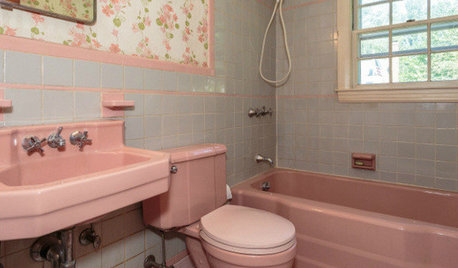buying an older home (1919)
ramazz
11 years ago
Related Stories

ADDITIONS7 Modern Additions to Older Homes
These contemporary add-ons go their own way as they play off the style of the original
Full Story
MOST POPULARHouzz Tour: Gracious Older Home Updated for a Young Family
A Texas designer lightens up and repurposes rooms, creating a welcoming space that suits this family’s casual lifestyle
Full Story
DECORATING GUIDES13 Decorating Tips for Older Homes
Preserve the personality of the past while designing for now with these tips for paint, rugs, window treatments and more
Full Story
BATHROOM COLOR8 Ways to Spruce Up an Older Bathroom (Without Remodeling)
Mint tiles got you feeling blue? Don’t demolish — distract the eye by updating small details
Full Story
UNIVERSAL DESIGNHow to Light a Kitchen for Older Eyes and Better Beauty
Include the right kinds of light in your kitchen's universal design plan to make it more workable and visually pleasing for all
Full Story
FURNITUREHow to Buy a Quality Sofa That Will Last
Learn about foam versus feathers, seat depth, springs, fabric and more for a couch that will work for years to come
Full Story
MOVINGHome-Buying Checklist: 20 Things to Consider Beyond the Inspection
Quality of life is just as important as construction quality. Learn what to look for at open houses to ensure comfort in your new home
Full Story
FEEL-GOOD HOMESimple Pleasures: 10 Ideas for a Buy-Less Month
Save money without feeling pinched by taking advantage of free resources and your own ingenuity
Full Story
PRODUCT PICKSGuest Picks: Beautiful Things You Can Feel Good About Buying
Upcycled, ecofriendly or just made responsibly, these home accessories and furniture pieces will keep your conscience clear
Full Story
DECORATING GUIDES10 Accessories Worth Buying for Fall and Beyond
Look to these versatile go-to pieces to keep your home feeling timely minus the full-blown seasonal makeover
Full StorySponsored
Central Ohio's Trusted Home Remodeler Specializing in Kitchens & Baths
More Discussions











columbusguy1
ramazzOriginal Author
Related Professionals
Carson Kitchen & Bathroom Designers · Clarksburg Kitchen & Bathroom Designers · College Park Kitchen & Bathroom Designers · Hammond Kitchen & Bathroom Designers · King of Prussia Kitchen & Bathroom Designers · Moraga Kitchen & Bathroom Designers · Ojus Kitchen & Bathroom Designers · Plymouth Kitchen & Bathroom Designers · Bensenville Kitchen & Bathroom Designers · Jacksonville Kitchen & Bathroom Remodelers · Vancouver Kitchen & Bathroom Remodelers · Enterprise Architects & Building Designers · Palos Verdes Estates Architects & Building Designers · Pedley Architects & Building Designers · South Barrington Architects & Building Designerssombreuil_mongrel
virgilcarter
ramazzOriginal Author
nwalter
ramazzOriginal Author
nwalter
paperkite
ramazzOriginal Author
brickeyee